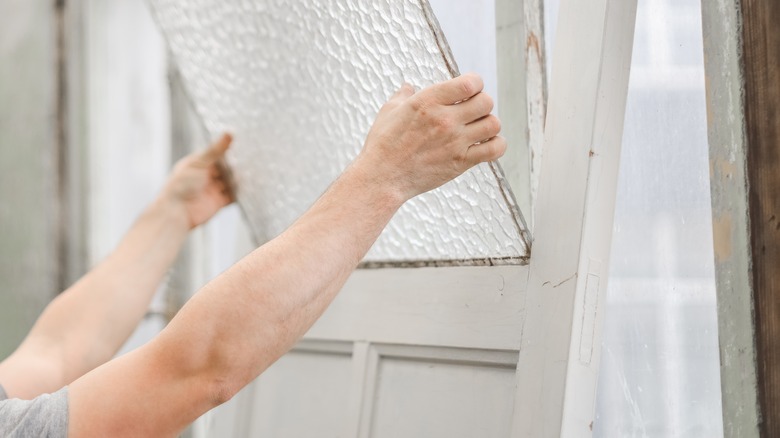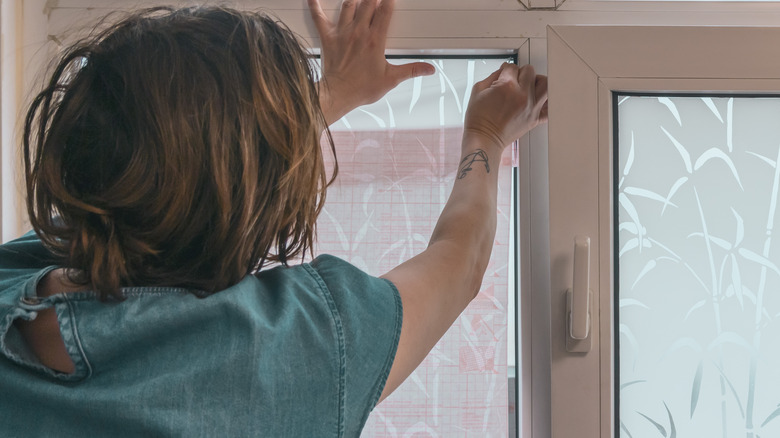Transform A Basic White Door With Gorgeous Textured Glass
A few decades ago, every homeowner seemed to be enamored with basic white-paneled interior doors. It was a clean, classic, and generally minimalist look, but it didn't have a lot of pizzazz. Every door was essentially the same. But now homeowners are seeking variety, sometimes wanting to put a personal stamp on the style in their homes beyond what they can do with furnishings or paint. Maybe you're feeling bored with your plain white doors or you're remodeling and feel like trying something new. Perhaps you couldn't resist that kind-of-homely-but-has-potential old door propped up next to a mailbox down the street from you with a "Free! Take me!" sign on it. If you're feeling handy and ready for a do-it-yourself project, you could transform a basic white door using textured glass, turning it into something gorgeous and special.
The transformation isn't an expert-level project, though it will require some skills, time, and tools. Since builders (and people who find doors with potential by the side of the road or at flea markets) have different types of doors to choose from, you'll first need to figure out what kind of door you have. Panel doors (usually molded or formed by the manufacturer) could work if the panel can be removed or cut out. Better yet, Dutch doors are ideal; they have an upper and lower section that normally already has a window in the top section. The project is fairly straightforward if you're handy with tools, but if you aren't, there's a hack for you.
A-door-able window upgrade that won't be pane-ful
If the door you're renovating has an existing window, you'll need to know how to replace the glass pane. Determine the method used to attach the glass to the door, contacting the manufacturer if necessary because, when installing a new glass pane, you may need to reuse some of the old door's parts and wouldn't want to destroy them in the act of removing the original glass.
Once the glass is out, you'll need to prepare the door itself, then get the new window pane into the open space you created in your door. Start by stripping and sanding the door, then staining or painting it. Finish with a top coat of varnish. For the window, select the textured glass and have the retailer cut it to your size, keeping it slightly smaller to allow for expansion. Your trim will cover any gap. It's doubtful that you'll need to go so far as to look for prismatic glass, which the University of North Carolina Greensboro highlighted in its Historic Dimension Series as revolutionizing Main Street retailers in the 19th century because it allowed daylight to reach farther into the stores. Select whatever style suits you, install it in the opening of the door's window frame using a tube of silicone sealant that's made for windows, and finish the project with trim all around the edges to secure the window to the frame.
Clinging to glass and still wanting privacy
Textured glass has the advantage of providing a measure of privacy when it's installed in place of plain clear glass. You might see shadows of people moving behind its panes, but you shouldn't be able to make out details. As with most upgrades in the existing windows, the ones you replace on a door could improve your heating and cooling bills by mitigating the heat or cooled air that is lost through the window, even if it's just between your steamy laundry room and the hallway.
Unfortunately, sometimes, finding just the right textured glass or a design that suits you can be challenging. You can still transform your basic white door with a new window, but try selecting a plain, clear glass window and using something else to make the window unique. You can add a personal touch or a little bit of flair by opting to cover the glass windows with something that imitates the look of textured glass, such as a window cling or window paint.
There is a wide array of window films available to add style to glass windows in doors, including ones that look like textured windows, although you might find yourself drawn toward stained glass designs in floral or geometric patterns. If you're seeking a creative window covering hack that isn't curtains, shades, or a cling, there are window sprays that can provide a frosted look, which will diffuse the light (but it won't look like a church window or a meadow).

